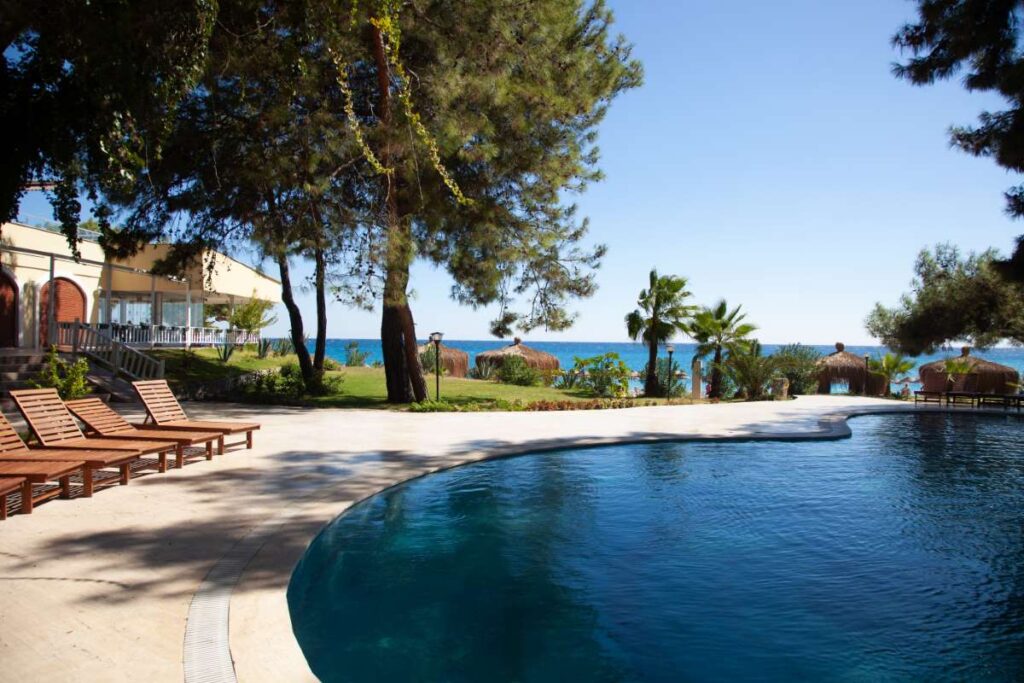Discover the science behind achieving crystal-clear pool water. Learn the essential chemistry and maintenance techniques to keep your pool sparkling clean.
The Chemistry Behind Clear Pool Water (Explained Simply)
Understanding the chemistry behind clear pool water is crucial for every pool owner. A sparkling pool not only enhances the aesthetic appeal of your backyard but also ensures a safe and healthy swimming environment. This blog post will delve into the fundamental chemical processes that keep pool water clear, the importance of balancing chemicals, and practical tips for maintaining your pool’s hygiene. We will cover key topics like pH levels, sanitizers, water balance, and common maintenance practices. By the end, you’ll have a comprehensive understanding of what it takes to achieve and maintain crystal-clear water in your pool.
Clear water is a reflection of proper pool management and maintenance, encapsulating the delicate balance of chemical interactions. Understanding the science behind it can empower you, whether you’re a seasoned pool owner or a newcomer navigating the waters of pool maintenance.
The Importance of pH Balance
The pH level of your pool water plays a critical role in its clarity and safety. Ideally, the pH should be maintained between 7.2 and 7.6. This range is optimal for swimmer comfort and ensures that sanitizers are effective. When the pH is too high, it can lead to scaling and cloudiness, while too low a pH can cause skin irritation and corrosion of metal fixtures.
To test your pool’s pH level, use a simple pH test kit available at any pool supply store. If the readings are off, you can adjust them using pH increasers or decreasers. Regular testing, ideally once a week, will help you catch imbalances early and prevent problems down the line.
Once you achieve the right pH balance, you can enhance your pool’s clarity by controlling the water’s alkalinity. Alkalinity acts as a buffer for pH, helping to stabilize it. The ideal total alkalinity level is between 80 and 120 ppm (parts per million). Keeping these levels balanced is essential for clear, inviting water.
Choosing the Right Sanitizer
Sanitizers are essential for keeping your pool water free from harmful bacteria and algae. Chlorine is the most common choice, and it comes in various forms, including tablets, granules, and liquid. Maintaining the appropriate chlorine levels—typically between 1 to 3 ppm—is vital for preventing algae growth and ensuring clear water.
Alternative sanitizers, such as bromine, ozone, or saltwater systems, can provide effective sanitation as well. Each has its pros and cons, but understanding your specific needs and preferences can help you make an informed decision. Chlorine is often favored for its cost-effectiveness and efficacy, while saltwater systems offer a gentler swimming experience.
Regular shock treatments, or superchlorination, can help eliminate organic contaminants and maintain clarity. By periodically raising chlorine levels significantly, you destroy chloramines—compounds that cause irritation and unpleasant odors. This practice is especially beneficial after heavy pool usage or during hot weather.
Understanding Water Balance
Water balance encompasses several key parameters, including pH, alkalinity, calcium hardness, and total dissolved solids (TDS). Each component affects water clarity, comfort, and equipment longevity. Calcium hardness, for instance, should be maintained between 200 and 400 ppm. Insufficient calcium levels can lead to corrosion of your pool’s surfaces, while excessive calcium can result in scaling and cloudy water.
Total dissolved solids reflect the concentration of dissolved materials in the water. Ideally, TDS should be below 1,500 ppm for optimal clarity. If TDS levels are too high, it’s often necessary to partially drain and refill the pool with fresh water.
Striking the right balance among these factors not only encourages clear water but also protects your investment in the pool. Regular testing and adjustments are essential for maintaining this equilibrium and preventing costly repairs.
Common Maintenance Practices
While understanding chemistry is essential, practical maintenance is just as crucial for achieving and maintaining clear water. Regular skimming of debris, vacuuming, and brushing the pool walls will help prevent algae growth and maintain aesthetics.
Installing a quality pool filter system is also vital. The filter circulates water, removing dirt and contaminants. Ensure your filter is adequately sized for your pool volume and replace or clean the filter media regularly for optimal performance. The pool pump plays a crucial role in this process, too; aim for at least eight hours of circulation each day, particularly during peak swimming season.
Consider investing in a robotic pool cleaner for additional convenience. These smart devices can efficiently scrub pool surfaces and collect debris, enhancing clarity without requiring significant manual effort.
The Role of Sunlight and Temperature
The sun plays a dual role in pool maintenance. While sunlight can help in keeping the pool warm and inviting, it can also contribute to chemical imbalances. UV rays can degrade chlorine levels, necessitating more frequent testing and adjustment.
To mitigate the impact of sunlight, consider using a pool cover when the pool is not in use. A cover can help retain heat, reduce evaporation, and limit debris accumulation. This simple practice can save you substantial effort in maintenance while improving water clarity.
The temperature of the water can also influence algae growth. Warmer water creates an ideal environment for algae proliferation, making it crucial to maintain proper chemical levels as the temperature rises. Increased chlorine levels may be necessary during hot weather to counteract this challenge.
Addressing Cloudy Water Issues
Even with diligent maintenance, you might encounter cloudy water from time to time. The causes could range from improper chemical balance to filter issues. Identifying the root cause is crucial for effective resolution.
If high pH or alkalinity is the culprit, use appropriate adjusting chemicals to rectify the imbalance. If cloudiness persists despite balanced chemistry, inspect your filter and ensure it is operating smoothly. Cleaning or replacing filter media may be necessary.
In some cases, you may need to employ a flocculant or clarifier. These chemicals help to bind small particles together, allowing your filter to remove them more effectively. However, use these sparingly and only when necessary, as overuse can lead to complications.
Understanding Pool Water Testing
Testing your pool water is an integral part of regular maintenance. By using a quality pool testing kit, you can monitor your pool’s chemical levels accurately. Test for pH, chlorine, alkalinity, and calcium hardness at least once a week, and more frequently during peak seasons.
Consider investing in a digital water tester for more precise readings and ease of use. These devices can provide you with quick and accurate results, helping you make timely adjustments to keep your pool water clear and safe.
Additionally, keeping a log of your testing results can help you identify trends and make informed decisions about maintenance practices. This data can also be beneficial when consulting with pool professionals for expert advice.
Conclusion
Maintaining clear pool water is a combination of understanding chemical interactions, regular testing, and diligent maintenance practices. By keeping your pH levels balanced, choosing an appropriate sanitizer, and understanding water balance, you can achieve that ideal clarity.
Regular care and attention will not only enhance the visual appeal of your pool but also create a safe and enjoyable swimming environment for family and friends. Don’t hesitate to reach out to professionals to assist you with specific needs or challenges you may encounter.
For those considering investing in a pool route, a clearer understanding of pool maintenance can be an invaluable asset. Explore the opportunities available with [Pool Routes for Sale](https://pool-routes-for-sale.com/) to start your journey in the lucrative pool service industry. Experience immediate revenue and grow your entrepreneurial spirit today!



